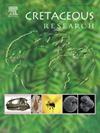巴西下白垩纪一种反鸟目鸟类的食鱼证据
IF 1.7
3区 地球科学
Q1 GEOLOGY
引用次数: 0
摘要
从巴西Araripe盆地的Crato组出土的单一标本中描述的Cratoavis cearensis是南美洲已知最早的鸟类化石之一(约117万年)。我们报告了与骨骼相关的分离鱼元素的存在,并将其解释为包含在这种反鸟鸟的消化道内。这些骨元素类似于大鲵(Dastilbe crandalli)的肋骨,大鲵是一种淋病鱼。在产生克拉托维斯火山的同一克拉托矿床中,有丰富的达斯蒂贝。已鉴定的骨骼元素为这种巴西反鸟鸟的食鱼性饮食提供了直接证据,从而为了解这一中生代鸟类主要分支的营养特化提供了微薄的证据。本文章由计算机程序翻译,如有差异,请以英文原文为准。

Evidence of piscivorous diet in an enantiornithine bird from the Lower Cretaceous of Brazil
Cratoavis cearensis, described from a single specimen unearthed from the Crato Formation of the Araripe Basin in Brazil, represents one of the earliest known fossil avians from South America (ca. 117 My). We report on the presence of disarticulated fish elements associated with the skeleton and interpret them as contained within the digestive tract of this enantiornithine bird. These bony elements are similar to ribs of Dastilbe crandalli, a fish belonging to Gonorynchiforms. Dastilbe crandalli is abundant in the same Crato deposits that have yielded Cratoavis cearensis. The identified bony elements provide direct evidence of a piscivorous diet for this Brazilian enantiornithine, thus contributing to the meager evidence available for understanding the trophic specializations of this major clade of Mesozoic birds.
求助全文
通过发布文献求助,成功后即可免费获取论文全文。
去求助
来源期刊

Cretaceous Research
地学-地质学
CiteScore
4.10
自引率
19.00%
发文量
235
审稿时长
12 weeks
期刊介绍:
Cretaceous Research provides a forum for the rapid publication of research on all aspects of the Cretaceous Period, including its boundaries with the Jurassic and Palaeogene. Authoritative papers reporting detailed investigations of Cretaceous stratigraphy and palaeontology, studies of regional geology, and reviews of recently published books are complemented by short communications of significant new findings.
Papers submitted to Cretaceous Research should place the research in a broad context, with emphasis placed towards our better understanding of the Cretaceous, that are therefore of interest to the diverse, international readership of the journal. Full length papers that focus solely on a local theme or area will not be accepted for publication; authors of short communications are encouraged to discuss how their findings are of relevance to the Cretaceous on a broad scale.
Research Areas include:
• Regional geology
• Stratigraphy and palaeontology
• Palaeobiology
• Palaeobiogeography
• Palaeoceanography
• Palaeoclimatology
• Evolutionary Palaeoecology
• Geochronology
• Global events.
 求助内容:
求助内容: 应助结果提醒方式:
应助结果提醒方式:


